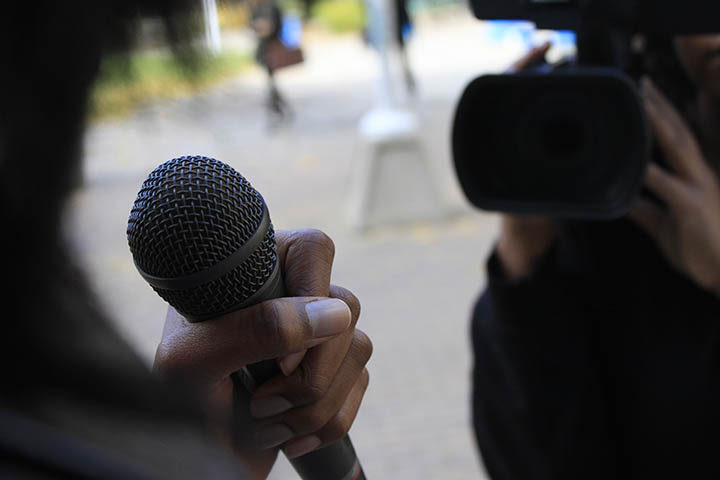FHRITP: Confront It or Keep Rolling?
New CBC guidelines address verbal sexual assault during live hits, but one recommendation might let harassers off the hook
CBC Montreal reporter Tanya Birkbeck was operating her own camera and interviewing a jersey-clad football fan in front of the Percival Molson Memorial Stadium in downtown Montreal. What happened next would leave her feeling violated. A young bearded man wearing a baseball cap, sunglasses and black hoodie approached, stared straight into the lens and yelled, “Fuck her right in the pussy!”
Five seconds later, another man, also dressed in black, jumped into the frame and repeated the vulgarity. That crisp day in November 2014 was the first time this had happened to her, but before long, being the target of the phrase—known as FHRITP and based on a YouTube video of a prank—became an all-too-common experience for Birkbeck and many other reporters. “It felt personal,” Birkbeck wrote in a cbc.ca op-ed. “Not just a catchphrase, but more of a taunt suggesting that the men around me, instead of talking to me, should be, you know, raping me.”
Many reporters, male and female, have also spoken out about how it feels to be subjected to FHRITP. “When you invade my space, grab my mike and yell that, you’re not just disrespecting my space as a working journalist,” the Calgary Herald’s Erika M. Stark wrote in an April 2015 Storify post. “You’re disrespecting and harming me as an individual. And, in this case, you’re disrespecting someone who has survived sexual assault.”
People have always shouted and waved in front of television cameras—it’s impossible to make sure live hits are never interrupted. But menacing, sexually-charged intrusions can be particularly distracting and upsetting for TV reporters, not to mention offensive to viewers. CBC has responded by providing a list of recommendations for how its reporters should handle sexual harassment in the field. These guidelines are a good first step, but nothing newsrooms can do will be enough to control outsiders’ behaviour and prevent verbal sexual assault. The only way it will stop is to educate people—especially young men—about why demeaning women is not okay, but one of the recommendations may actually get in the way of that.
In spring 2015, Brenda Murray, a senior producer at CBC in Toronto, was worried about how often FHRITP would happen during the summer, when live hits in the middle of crowds are more frequent because of the warmer weather and greater number of outdoor events. “I wanted to see that the corporation showed that we were engaged,” she says, “and any sort of armour that we could prepare the reporters with, the better.”
She forged that armour as part of a 12-person committee—unofficially called the National Safety in the Field Committee—of reporters, editors, executives and HR staff that met to decide how to protect reporters from FHRITP and other forms of harassment. Some members, including Birkbeck in Montreal, joined in through a conference call with the Toronto-based staff. The committee gathered information and ideas from journalists, lawyers, police officers and security professionals. In June, it released recommendations for dealing with field harassment. Training for reporters is in the works, though no start date has been announced.
The strategies, which have been shared with CTV, City and Global, include asking event security to stand nearby, documenting all incidents and not confronting a harasser. “We don’t want to escalate the situation,” the memo sent to CBC staff reads. “Your safety is paramount, and it’s hard to predict how individuals might react to words or gestures which could be seen as provocative.” Greg Reaume, managing editor of CBC news coverage, says choosing how to react in the moment is an individual decision. But this controversial part of the memo pushes reporters in a more passive direction.
That’s a problem because when reporters do say something, either to the harasser or over social media, the incident often sparks a wider conversation about FHRITP and sexual harassment. The most prominent example happened last May, when Shauna Hunt of CityNews overheard a group of men planning to interrupt an interview with FHRITP. She confronted them and challenged them to explain why they thought it was so funny. The resulting conversation about FHRITP—and the sexual harassment of female reporters—reached a fever pitch in the news and on social media. One of the men lost his job at Hydro One as a result of the controversy.
Julie Lalonde, an Ottawa-based women’s rights advocate, says that while she sympathizes with broadcasters trying to keep their employees safe, instructing people to ignore harassers every time is misguided. “Their directive in that memo is, ‘Don’t feed the trolls,’” she says, but that approach means missing the opportunity to hold people accountable for their actions. Lalonde argues that Hunt was in a safe situation: the middle of a crowd in daylight and accompanied by a cameraman. That is the ideal position to directly confront a harasser and encourage a societal shift away from accepting such behaviour.
There are signs that the trend might be dying out—Reaume says there has been a decrease in the number of incidents being reported, and Birkbeck says it hasn’t happened to her since before the summer—but sexual harassment is not new, and it lives well beyond the lifespan of a singular phrase. That’s why it’s important to continue talking about how unsafe journalism can be for women, because the only way to prevent such incidents is to make them socially unacceptable.
That will finally be the case when what happened to Birkbeck’s colleague Morgan Dunlop becomes the norm. She was interviewing music fans at Montreal’s Osheaga Music and Arts Festival this summer when a young man interrupted them by saying FHRITP. But Dunlop didn’t need to decide whether to confront him. The fan she was interviewing, a young 20-something man, did it for her: “Hey man, that’s not cool.”
Update: The man who lost his job at Hydro One after defending FHRITP on camera to Shauna Hunt was back at work on November 2, but Hydro One did not confirm that today was his first day back. Hunt tweeted that the company had let her know in advance. Hydro One said in a statement that it resolved the issue through an arbitration process and that it would it would not comment any further.
Related Posts
 Ghomeshi trial day one verdict: Victim blaming
Ghomeshi trial day one verdict: Victim blaming Remember the women, forget Ghomeshi
Remember the women, forget Ghomeshi PODCAST: Allegations of Jian Ghomeshi & the role of journalists covering sexual assault
PODCAST: Allegations of Jian Ghomeshi & the role of journalists covering sexual assault Is La Presse+ the solution to newspaper woes or a capitulation to advertisers?
Is La Presse+ the solution to newspaper woes or a capitulation to advertisers?  Whose brand is it anyway?
Whose brand is it anyway? Jane Armstrong takes her passion for investigative journalism to The Tyee
Jane Armstrong takes her passion for investigative journalism to The Tyee
Elena is the chief copy editor of the spring 2016 issue of the Ryerson Review of Journalism.









































